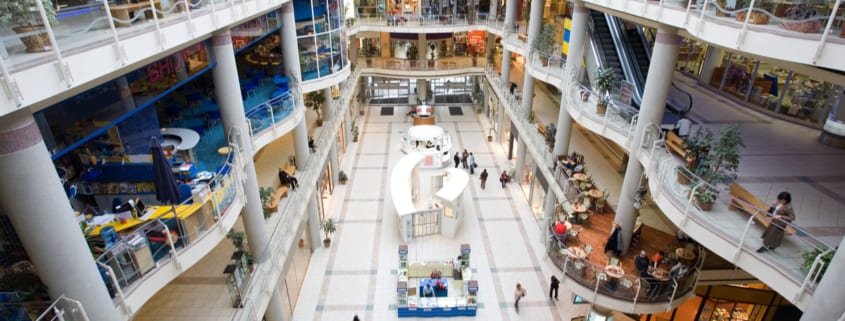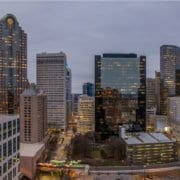The Birth, Death, and Resurrection of Shopping Malls
McKinsey defines shopping malls as “one or more buildings forming a complex of shops representing merchandisers, with interconnected walkways enabling visitors to walk from unit to unit”. With origins in the US, shopping malls have now become a full-blown retail trend across the globe. But times are changing, and the shopping mall of the mid 1950s can no longer meet the needs of the modern 21st-century consumer. With these changes in mind, the traditional definition may no longer be applicable.
Let’s take a look at the evolution of shopping malls in America and try to understand what this means for commercial real estate today.
Birth of Shopping Malls
People spend most of their time in three places: home, work, and social situations (commonly referred to as “the third place”). These social spaces are thought to be critical to building relationships, promoting civic engagement, and establishing a sense of belonging. Traditionally, these third places were venues such as churches, libraries, parks, cafes, or even a beauty parlor of barber shop. But as people began to migrate to the suburbs in the 1950s, they found that there were fewer opportunities to gather with friends, run into neighbors, or spontaneously meet new people.
There are a few factors at play here. First of all, single-use zoning meant that these traditional third places were less accessible and convenient, often requiring a trip in the car. As such, it has often been criticized as destroying communities. Secondly, the decreased walkability to these third places meant that social engagements have to be planned and deliberate, requiring more planning and logistics.
The answer? Shopping malls – the idyllic social center for the suburbs. Over the past 50+ years, the number of shopping malls in America has quadrupled, offering a blend of fashion, convenience, and boutique stores to suburbanites.
Death of Shopping Malls
It’s no secret now that shopping malls are struggling and, in some cases, even abandoned. So, what happened?
The rise in online shopping has essentially made malls irrelevant. Department stores are typically the anchor tenants in malls, but they continue to make the news as names such as JC Penney, Sears, Kmart, Macy’s Kohl’s, and even Neiman Marcus announce plans to shut down hundreds of locations. If it were one or two companies, this wouldn’t necessarily be a problem, but this issue is plaguing the entire retail sector. And without the anchor store, the viability of the mall ecosystem is jeopardized.
Let’s look at a quick example. Food courts are always a busy, bustling place in the mall. But without the traffic brought in by the anchors, there would be nobody to even go to the food court. And boutique and smaller retailers similarly rely on the traffic drawn by those department stores.
Nationwide, there are approximately 1,200 shopping malls, but a 2017 survey from Credit Suisse estimates that 25% of those will be gone within 5 years. Mall operators are justifiably concerned. Other retailers often sign agreements based on anchor tenants, and many leases allow them to reduce their rent or get out of their lease if one of those stores closes. As malls increasingly appear to be more and more deserted, some developers are looking for ways to reinvigorate these suburban symbols.
Resurrection of Shopping Malls
The latest trend is to return shopping malls back to that “third place” concept as a social space, incorporating more food halls, communal areas, and entertainment options that will transform the mall into a destination and provide more of an experience that will attract shoppers. The shopping malls that will be most successful are those that have transitioned from a place to conduct a purchase to a lifestyle center that offers a multi-dimensional experience.
Increasingly, we see more non-traditional tenants, including:
- Gyms, CrossFit boxes, and yoga studios
- Trendy bars, social clubs, and other forms of nightlife
- Upscale restaurants
- Gourmet food vendors and grocers
- Hip hotels
- Co-working offices
- Spas
With an eye toward creating experiences, malls are beginning to incorporate more services and amenities, such as the following:
- Pop-up event spaces (such as for touring museum exhibits)
- Art galleries
- Aquariums
- Public library outposts
- Luxury movie theaters
- Upscale bowling alleys
- Outdoor amphitheaters and concert stages
- Kitchens offering cooking classes
- Fitness classes
- Children’s play areas and splash pads
- Green space and communal patios and terraces with hammocks, fire pits, and lounges
Additionally, US malls are investing billions of dollars to renovate, improving aesthetics and elevating curb appeal with green areas, improved wayfinding, skylights, modern architectural updates, and more communal spaces. Further, about 20% of malls are also upgrading from completely enclosed spaces to partially or completely open-air streetscapes.
Along with these improvements often comes rebranding, in efforts to rebuild the outdated image associated with malls of the late 1900s. According to a JLL survey, during the renovation process, 1 in 5 malls removes the word “mall” from their name, trending toward terms such as “shops”, “village”, “galleria”, or “town center” – words that denote community, intimacy, and luxury.
Through this evolution, malls have come to represent more than just a “complex of shops”, transitioning into a carefully curated collection of tenants that encourages social activity and promotes community.
For more information on shopping malls and adaptive reuse of commercial spaces, check out our post on what to do with vacant commercial property.











